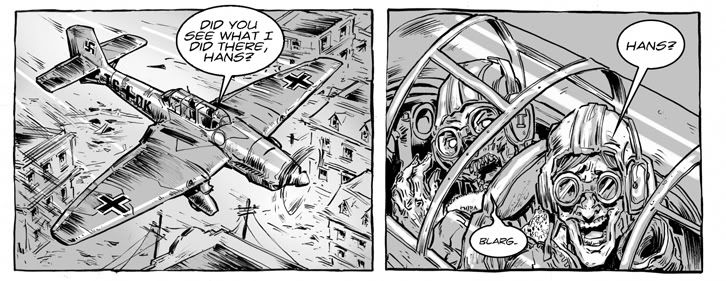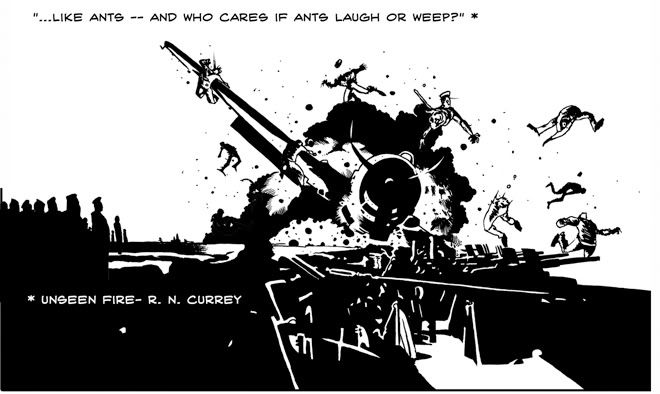So You Want to Do an Anthology?
 Writer/Artist Jeff McComsey took a few minutes away from managing his massive World War II zombie anthology Fubar, to share some thoughts on what it takes to run a successful anthology.
Writer/Artist Jeff McComsey took a few minutes away from managing his massive World War II zombie anthology Fubar, to share some thoughts on what it takes to run a successful anthology.
Jeff, in your opinion, what makes a good anthology?
I think one of the most important things needed for an anthology to work is a fun theme. Long before you’re asking strangers to throw down their hard earned money for your antho, you’re asking a bunch of your fellow creators to give their time to create it. If the theme doesn’t get them excited, they’ll probably pass.
 I know personally I love the chance to shift gears from a long-term project and knock out a few pages of a short with an intriguing theme that I’ve always wanted to take a stab at like sci-fi, Western, etc.
I know personally I love the chance to shift gears from a long-term project and knock out a few pages of a short with an intriguing theme that I’ve always wanted to take a stab at like sci-fi, Western, etc.
A strong theme also helps when you’re pitching the book to people at cons who may want to buy it. Each theme/genre has its own fan base and you want to appeal to them as best you can. In addition to fan bases, you have websites that specialize in your theme which you will want to avail yourself to for marketing purposes. For instance with FUBAR we have zombies and WW II. We’ve found some great sites between the two that are interested in the project and gave us great write-ups.
What was been the toughest part about putting together the original Fubar anthology?
The toughest part is the organizational aspect. Initially, it’s a lot of scripts in various stages of completion that need revisions and notes. Then it becomes the same for the art. This story needs a letterer or this one needs grayscales. Luckily, I have good help with the story editing aspect from Jorge Vega. As an artist/creator that works almost exclusively in the small-press realm, I’ve had to learn how to pencil, ink, grayscale, color and letter, so if a story needs something in the art department I can jump in and make sure it gets locked in. This is invaluable towards the end of the process when the loose ends start to add up.

Was there anything you learned from that process that you applied to FUBAR II?
I think the most important aspect I gained is confidence that the process works. This new volume has quite a few more creators so the organizational aspesct was a bit more intense, but still manageable. With the first volume we had no idea if it would work and if it did work would anybody want to buy one. The first volume exceeded my expectations in terms of sales and response so I figured all we needed to do was rinse and repeat for volume 2. I started a little earlier in the year for this volume and that helped ease the mad crunch before print time.
In your role, have you been a “matchmaker” pairing good stories with good artists? Or were complete creative teams coming to you?
One of the most satisfying aspects is the pairing of teams. Sometimes it’s practical because a certain type of script needs an artist with a certain set of skills, so I do my best to get a smart pair up. Sometimes, it’s just an inkling that a certain pair would make sweet comics together. I would say probably 25% or less of the teams come already paired but the majority are put together.
Any advice for a creator looking to put together his own comics anthology? Dos and don’ts?
A big DO: Get a partner. Find someone to help you out with organizational/motivational aspects of what can be a very trying process at times. I’m lucky to have a partner in crime like Steve Becker. He’s a maniac who has been gung-ho about the project from the get. He’s responsible for our awesome booth that has given us a real presence at conventions, as well as our zombie combat targets that are an excellent piece of merch for FUBAR. We keep each other fired up and on a mission. It’s invaluable to have that kind of support.

A big DON’T: When soliciting your fellow creators for their work for an anthology, do not put out blanket requests via Facebook and Twitter asking for people who are interested. You may get a few responses, but what I find is much more effective is to make a list of all the creators you want involved and contact them individually. Tell them why you want them involved (hopefully because you’re a fan of their work) and be flexible with their schedules. This has worked ON me and FOR me. Also, know that people will have to bow out of projects for various reasons. It’s nothing personal. Be prepared.
What’s next for FUBAR?
Right now we’re running a KICKSTARTER to help finance the offset print run of FUBAR II: Empire of the Rising Dead. It’s a great place to pick up both FUBAR I and FUBAR II, as well as some of our Zombie combat targets and a bunch of custom art. If you do, mention that you heard about it on ComixTribe and we’ll throw in a little something extra for you:)
In addition to Volume II Steve Becker and I are working on another FUBAR book. It’s sort of a FUBAR: Grindhouse OGN. He and I are both expanding one of our shorts into a 80-100 page stand alone story and we’ll be putting both stories into a double book. Half will be my story MOTHER RUSSIA from volume 1 and Steve’s will be his RADIO BASE Z story from volume 2. We’re shooting for a spring release right now and of course, FUBAR volume 3 lurks somewhere in the near future with a theme to be announced soon.
Where can we buy the books?
The Kickstarter is the best bet to grab Volume I and Volume II( Volume II won’t be in comic shops until December but you can get it in September through Kickstarter) We also do your choice of WW II zombie sketches on the front page of each book if you go through Kickstarter. Other than that, your local comic shop should have a copy or can order a copy from Diamond. You can also order the book from places like Amazon.com and Barnes and Noble. Volume II will be listed in PREVIEWS in October for a December release.
Related Posts:
Category: Trenches

















So…. anthologies aren’t always a headache of disorganization and missed deadlines?